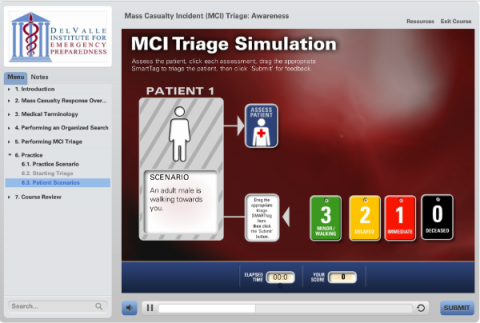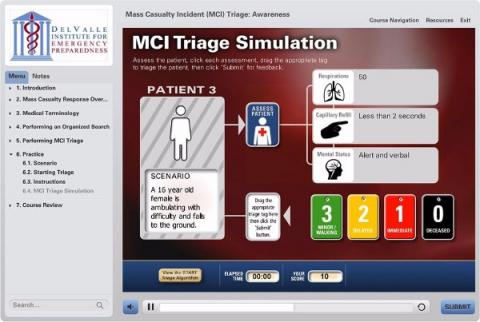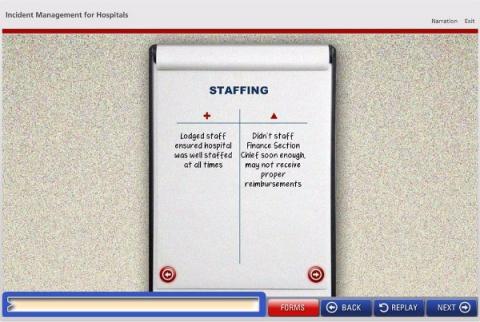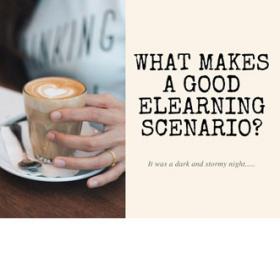Five Steps to Stellar Scenarios
Ideally, what would you want your audience to take away from their learning activities? You’d like them to emerge with expanded knowledge or skills, and the inclination and confidence to apply them at work. We know that stories increase learner interest in our content. When the learner is the central character in a story, making decisions as a player and discovering the outcomes of their choices, we call it a scenario. They become more engaged as they practice their new skills in a safe environment. That’s what makes scenario-based learning so appealing – done well, it’s the closest you can get to the learner performing on the job. So how do you do it well? Here’s our five-step formula.
Step One: Make the Scenario Realistic
It’s critical that you design scenarios that give a close approximation of what you want the learner to be able to handle once they’ve completed their training. That usually requires striking a balance, with enough detail to be appropriate and enable the learner to do their job, but not necessarily every aspect they’ll run into in the real-life situation. Let’s look at this example, from a course developed together with instructional-design partner EnVision Performance Solutions, for their client Boston Emergency Medical Services’ DelValle Institute for Emergency Preparedness, on Mass Casualty Incident (MCI) Triage. This course was designed for first responders, to prepare them to quickly assess the medical and treatment status of victims in cases where you have more affected people than the initial medical resources can handle. In thinking about this course, DelValle decided to go with a narrative description of the victims and their injuries; they didn’t want learners focused on gruesome photographs. Instead, the learner’s attention is directed towards assigning a color tag for the victim, just as they would have to do at a real accident scene.
In this case, the learner gets points for how well they can select the tag, with primary emphasis given to the correct color (status), and secondary emphasis given to how fast the decision gets made, since both factors are important. This idea of multiple factors with relative impact helps make for a realistic scenario.

Step Two: Create Decision Points and Alternate Paths
Scenarios fall into two basic types – those where decisions have correct and incorrect answers, and those where there is no definitively right or wrong answer. Our MCI Triage example is in the first category, with a single correct answer for each accident victim. Both types can be appropriate, depending upon which one better represents the situation that the learner will face on the job. Think about the situations you want your learners to be able to handle, and choose the right type of scenario.
Another secret to maximizing the value of your scenario can be to break down more extended actions or decisions into component parts. For instance, in a medical scenario, you could divide the learner’s activity in a particular case into selecting the right test for a particular condition, and then making the best determination from the results of the selected test. By dividing it this way, there’s a better chance for the learner to realize and retain each part of what they need to do, rather than being unsure at the end whether their problem was due to their choice of test or the interpretation of the test results.
Another attribute of a good scenario can be to provide alternate ways for learners to make the desired decision. Turning again to our MCI Triage example, the screenshot below shows how, in determining the victim’s status, the learner can ask to “Assess Patient,” and they receive additional information on respirations, capillary refill rate, and mental status. This element makes the scenario more realistic because this may not be necessary for either a clear-cut case or a more experienced learner, but may be a wise choice for a less experienced learner or for a more ambiguous case. So realism is not just a matter of the case presented, but also the methods chosen by the learner to reach a conclusion.

Step Three: Give the Learner Feedback
To get maximum value from your scenario, it’s valuable to give the learner feedback on their decisions. This can be provided as information on a single decision, or as a number of comments when they’ve had to make multiple decisions.
For scenarios with right and wrong answers, be sure to explain why an answer is right, as well as why an answer is wrong. You want to make sure that the learner really understands the reason for the correct choice, and didn’t just make a “lucky guess.” It also helps to point the learner to any spots or resources for additional information, in case they’d like or need to learn more.
For more complex scenarios without right or wrong answers, you need to supply a different type of feedback, indicating the benefits or strengths of the learners choices, and also any problems or weaknesses from their selections. For example, the screenshot below comes from a different course done for DelValle Institute for Emergency Preparedness – this one a course on Incident Management for Hospitals, teaching hospital staff to deal with special types of events, like a major storm. In this scenario, the learner was called upon to make a number of decisions, on staffing, medical practice, and other aspects of hospital operations. At the end of the scenario, the user received feedback highlighting the major pros and cons of the decisions they made. This particular screenshot covered the consequences – positive and negative – of the staffing decisions that the learner made in going through the scenario.

Step Four: Repeat When Possible
If you can, give the learner the opportunity to maximize their learning by going through the scenario multiple times, selecting different paths. This gives them a chance to see more situations and outcomes, and learn more from their decisions.
Of course, it helps to make the scenario interesting by having it not be a literal repeat. In cases where there are right and wrong answers, like the MCI Triage scenario shown above, potentially you could have 20 – 30 or more victims, with the learner being presented with 10 each time the scenario gets run. The cases could be selected at random, or the order can be varied.
Scenarios without right or wrong answers, but with branches where decisions lead to different choices or consequences, are naturals for repetition. In such examples, the learner may be naturally curious and motivated to see how other selections will work out.
Step Five: Consider Gamification Elements
You can sometimes kick the learner’s motivation into overdrive if you can introduce a competitive element. Many learners respond positively to seeing how their performance in the scenario compares with others. Even if you don’t have the ability to compare with others, it can often be just as motivating to have the learner see if they can best their own past performance. Such competition even motivates learners to tell others about the scenario and their performance, increasing the likelihood that others will take the training and put their energy into it.
Conclusion
Scenarios make for powerful learning, because they take the learner beyond acquiring knowledge just to perform on a test, and give them the chance to apply what they’ve learned to deal with the kinds of situations you want them to handle well. Not only does this provide better understanding and usage, the direct actions make for better retention, too. Make sure you build the right type of scenario(s), to make the most of this learning opportunity!
Scenarios are one of our specialties. Help us help you make your content resonate and transfer to your learners. Give us a call today.




